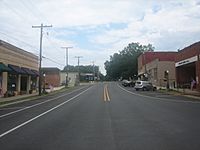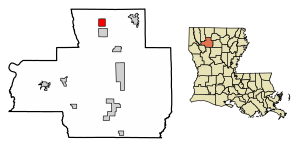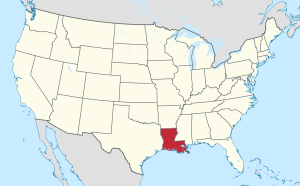Gibsland, Louisiana facts for kids
Quick facts for kids
Gibsland, Louisiana
|
|
|---|---|
|
Town
|
|

Downtown Gibsland
|
|

Location of Gibsland in Bienville Parish, Louisiana.
|
|

Location of Louisiana in the United States
|
|
| Country | United States |
| State | Louisiana |
| Parish | Bienville |
| Area | |
| • Total | 2.65 sq mi (6.87 km2) |
| • Land | 2.63 sq mi (6.82 km2) |
| • Water | 0.02 sq mi (0.06 km2) |
| Elevation | 272 ft (83 m) |
| Population
(2020)
|
|
| • Total | 773 |
| • Density | 293.58/sq mi (113.36/km2) |
| Time zone | UTC-6 |
| • Summer (DST) | UTC-5 (CDT) |
| Area code(s) | 318 |
| FIPS code | 22-28835 |
Gibsland is a small town in Bienville Parish in northern Louisiana, United States. In 2020, about 773 people lived there.
Gibsland is famous for a few things:
- It has important railroad connections.
- It was the home of Coleman College, an important school for Black students.
- It's the place where the famous outlaws Bonnie Parker and Clyde Barrow were caught and killed by law enforcement on May 23, 1934.
A person from Gibsland named John McConathy was a champion basketball player at Northwestern State University. He later became a school superintendent and helped create Bossier Parish Community College.
Contents
History of Gibsland
Coleman College: A Special School
Coleman College, also called Coleman Academy, was a school for African American students. It was started in Gibsland in 1887 by O. L. Coleman. This was the first high school for Black students in northern Louisiana.
The school was connected to the Baptist Church. It helped train many teachers and ministers. Coleman College stayed in Gibsland until 1937, when it closed during the Great Depression. It later reopened in Shreveport in 1943 and stayed there until the 1950s.
Gibsland's Railroad Story
Gibsland became a town in 1889. The Louisiana & North West Railroad Company runs a special kind of train line, called a shortline, for 62 miles. This line connects Gibsland to McNeil, Arkansas.
This railroad connects with other big train lines. It meets the Union Pacific railroad in McNeil. It also connects with the Kansas City Southern in Gibsland.
For many years, train fans loved this railroad because it used unusual F7 "covered wagons" trains. These were special types of locomotives. Later, these were replaced by other types of trains called "Geeps." The main train repair shops for the LNW railroad are in Gibsland. They are very close to a busy spot where three different railroads used to meet. This busy train activity was even called the "Gibsland Shuffle" by railfans!
The End of Bonnie and Clyde
On May 23, 1934, Bonnie Parker and Clyde Barrow were famous bank robbers. They were stopped and killed by police officers. This happened near Gibsland, on Louisiana Highway 154, south of the town.
Where is Gibsland?
Gibsland is located in the northern part of Bienville Parish. You can find it at coordinates 32°32′34″N 93°3′13″W / 32.54278°N 93.05361°W.
The United States Census Bureau says the town covers about 2.65 square miles (6.9 square kilometers). A very small part of this area, about 0.02 square miles (0.06 square kilometers), is water.
People of Gibsland
| Historical population | |||
|---|---|---|---|
| Census | Pop. | %± | |
| 1900 | 558 | — | |
| 1910 | 1,065 | 90.9% | |
| 1920 | 798 | −25.1% | |
| 1930 | 1,090 | 36.6% | |
| 1940 | 1,023 | −6.1% | |
| 1950 | 1,085 | 6.1% | |
| 1960 | 1,150 | 6.0% | |
| 1970 | 1,380 | 20.0% | |
| 1980 | 1,354 | −1.9% | |
| 1990 | 1,224 | −9.6% | |
| 2000 | 1,119 | −8.6% | |
| 2010 | 979 | −12.5% | |
| 2020 | 773 | −21.0% | |
| U.S. Decennial Census | |||
The table below shows the different groups of people living in Gibsland in 2020:
| Race | Number | Percentage |
|---|---|---|
| White (not Hispanic) | 70 | 9.06% |
| Black or African American (not Hispanic) | 660 | 85.38% |
| Native American | 1 | 0.13% |
| Other/Mixed | 25 | 3.23% |
| Hispanic or Latino | 17 | 2.2% |
In 2020, there were 773 people living in Gibsland. There were 261 households and 161 families.
Education in Gibsland
The Bienville Parish School Board manages the schools in Gibsland. Students from kindergarten to 12th grade attend Gibsland–Coleman High School.
Fun Things to Do and See
Festivals and Events
Gibsland has two main yearly festivals:
- The Jonquil Jubilee and Historic and Garden Tour: This festival helps local gardeners with advice from botanists (plant experts).
- The Bonnie and Clyde Festival: This festival celebrates the story of Bonnie and Clyde.
The Bonnie and Clyde Festival
The Bonnie and Clyde Festival happens in Gibsland in mid-May. A fun part of the festival is a play where actors pretend to rob a bank, just like Bonnie and Clyde. This festival has even been shown on the TV show Weird U.S. on the History Channel. Remember, Bonnie and Clyde were caught near Louisiana Highway 154, south of Gibsland.
Bonnie and Clyde Ambush Museum
Gibsland is home to the Bonnie and Clyde Ambush Museum. This museum is in the building that used to be Ma Canfield’s Café. This was the last place Bonnie and Clyde ate a meal before they were caught.
Perry Carver owns and runs the museum. Linton Jay "Boots" Hinton, whose father was part of the police group that caught Bonnie and Clyde, used to manage the museum. The museum also talks about the local police officers who helped, like Bienville Parish Sheriff Henderson Jordan and his chief deputy, Prentiss Oakley.
Gibsland-Coleman Alumni Association
The Gibsland-Coleman Alumni Association was started in 1981. This group is for former students of Coleman College and others who want to support the school. They mainly give college scholarships every year to students graduating from high school.
The association has groups in Houston, Los Angeles, and Gibsland. They hold a reunion in Gibsland every year during the first weekend of July.
Famous People from Gibsland
- Charles M. Blow: A journalist and writer for The New York Times.
- Jesse N. Stone: The first African American judge on the Louisiana Supreme Court.
- Victor King: A Louisiana Tech Bulldogs basketball player who was drafted by the Los Angeles Lakers.
- Bernard King: Victor King's son, a Texas A&M Aggies men's basketball player who played basketball professionally overseas.
- Ralph Hamner: A professional baseball player for the Chicago White Sox and Chicago Cubs.
- John McConathy: A Northwestern State Demons basketball player who was drafted by the Syracuse Nationals.
- W. C. Robinson: The second president of Louisiana Tech University.
- Sam Smith: The first African American to be a city councilman in Seattle.
- Jimmy Wilson: A blues musician.
- William E. King: A state lawmaker in the Illinois House of Representatives.
Images for kids
-
Gibsland Bank and Trust Company also has a branch in nearby Minden.
-
First United Methodist Church in Gibsland
-
First Baptist Church of Gibsland
See also
 In Spanish: Gibsland para niños
In Spanish: Gibsland para niños









